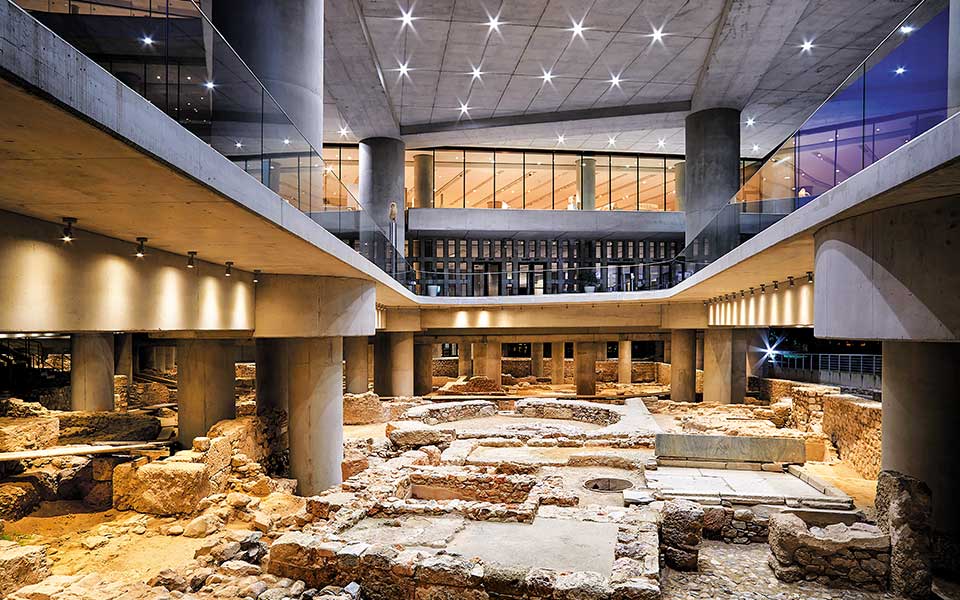The wonders of the Acropolis Museum just get better and better. Now, ten years after its inauguration, the museum has opened its last (or perhaps only its latest) permanent exhibit: the extensive archaeological excavation site that lies beneath the building, where a portion of an ancient Athenian neighborhood has been brought to light.
A GOLDEN OPPORTUNITY
In the 1990s, as plans gained momentum for the establishment of a new Acropolis Museum – as well as for a new “Acropolis” metro station and the unification of central Athenian archaeological sites with the conversion of Areopagitou Street into a pedestrian thoroughfare – visible signs of change began to appear in the neighborhood south of the Acropolis. Houses, apartment buildings and small businesses, including an aged traditional taverna with the intriguing name of “Socrates’ Prison,” began to be purchased and demolished to make space for what was coming.
As the foundations and basements of these contemporary structures were cleared away, an unseen part of the ancient city of Athens began to emerge. The extraordinary opportunity to explore a large, previously hidden section of Athens’ past could not be lost, so archaeologists, officials and benefactors scrambled into action.
It is a tribute to these groups, and to the leaders of the new Acropolis Museum project, that, despite the inconvenience to architects and builders, the “Makrigianni site” was preserved and embraced, almost literally, by the fabulous new structure erected above it. Archaeologists and engineers worked closely together to find exactly the right spots – in many cases new locations, different from those indicated in the original plans – for the massive support columns that would carry the new building. Thanks to these collaborative efforts, we now have a glimpse into a long-inhabited district whose archaeological remains, covering 4,000 square meters, date from prehistoric times through the Byzantine era.
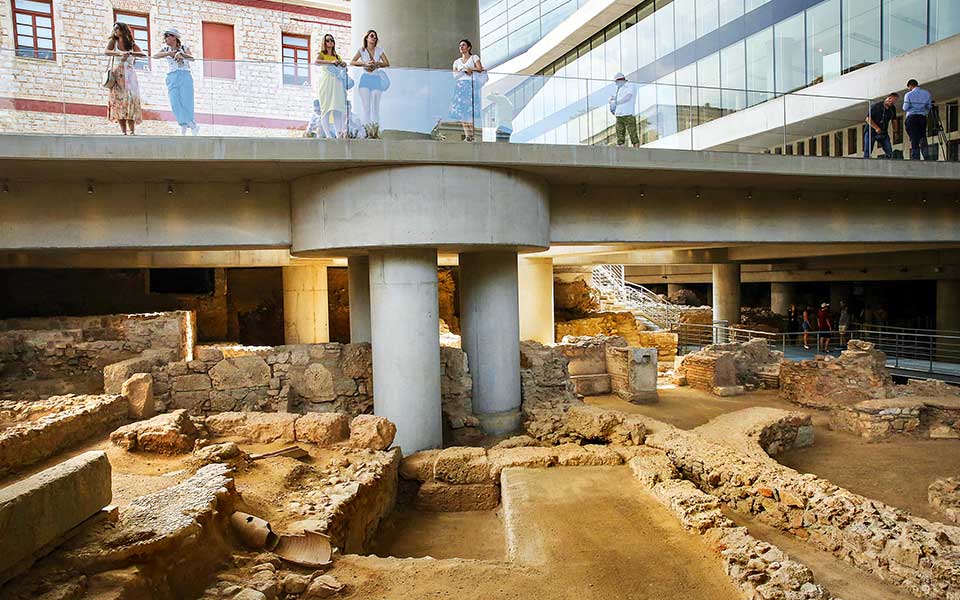
© EPA/Orestis Panagiotou
EXCAVATIONS BEGIN
Today, as we stroll along the elevated walkways beneath the Acropolis Museum, the tidy presentation and hushed atmosphere of the excavation site belie the great tumult of activity that took place here, both in ancient times and during the more recent transformation of the site.
Led by archaeologist Stamatia Eleftheratou, excavations began in 1997 and, with occasional breaks, continued until 2007. The project was conducted under the auspices of the 1st Ephorate of Prehistoric and Classical Antiquities (EPKA) and the Organization for the Construction of the New Acropolis Museum (OANMA), in collaboration with the museum’s visionary president, Prof. Dimitrios Pandermalis, the long-time director of excavations at Dion.
The diverse Makrigianni team, Eleftheratou recalls, included archaeologists, engineers, conservators, craftsmen and other workers; it was a team of nearly two hundred people at its peak. In recent months, activity on the site once again increased, as the museum prepared to open the excavations to visitors on June 21st, 2019, the day after its ten-year anniversary celebration.
AN URBAN HONEYCOMB
Traces of Neolithic inhabitation have been found on the Makrigianni site, revealing that people were already living in this area adjoining the Acropolis as early as the 4th millennium BC. From about 2000 BC, the area became a more substantial settlement, as well as a place of industrial activity and a burial ground.
As Athens grew, the Makrigianni site came to be a neighborhood of the Classical city, eventually developing into a densely built-up and inhabited district during Roman and Byzantine times. Archaeologists, as they peeled back the earth, exposed a honeycomb of walls, streets, alleys, houses, baths and workshops, some as far down as five meters or more below present ground level. The preserved height of some of these millennia-old remains is impressive.
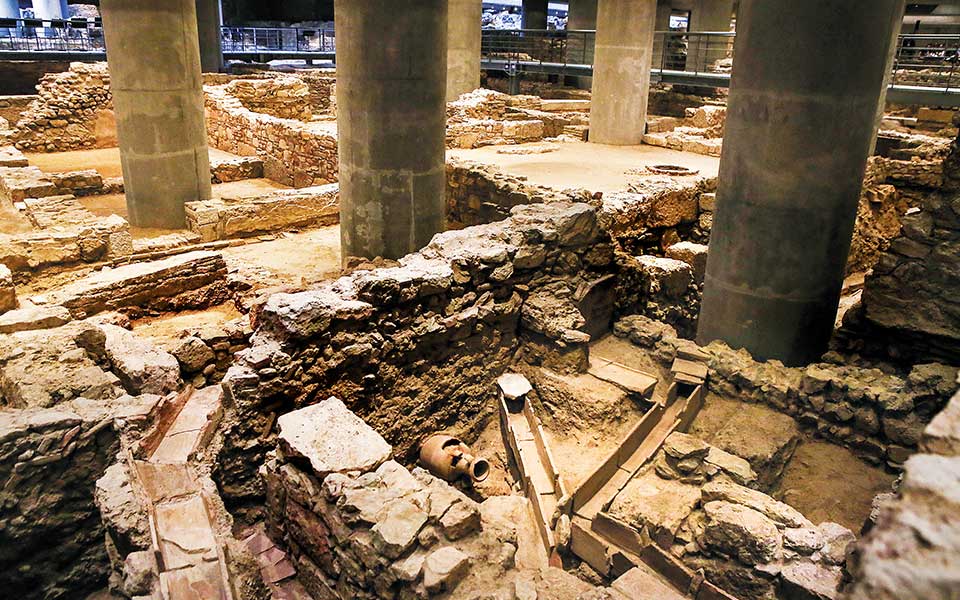
© Panagiotis Tzamaros/Intime News
The Makrigianni neighborhood, located some distance from the ancient city’s center at the Athenian Agora on the other side of the Acropolis, was initially developed as a systematically planned quarter following the Persians’ destructive invasion of Athens in 480 BC, then further expanded in the late 5th century BC. Here, residents had direct access to the important public areas on the Acropolis’ southern slopes, including the Sanctuary and Theater of Dionysus, the Sanctuary of Asclepius, the Sanctuary of the Nymphe and the Odeon of Pericles.
By Roman times, the district was also home to numerous wealthy Athenians living in large city houses, side-by-side with more humble, middle-class dwellings. The area was additionally enhanced by the Odeon of Herodes Atticus (AD 161).
Within the Makrigianni site, at least two major crossroads – one possibly furnished with a public fountain – as well as other smaller streets indicate the neighborhood was well-connected to the larger city network. The area’s main streets were surfaced with packed earth and gravel, worn and rutted from the passage of pedestrians and wheeled traffic. Below ground, there ran a sophisticated arrangement of sewer pipes or channels to carry away water and waste from latrines, baths and workshops.
WHAT WE SEE
The ruins beneath the museum help us understand the amazing complexity of the archaeological remains and the lengthy period of habitation they represent. Excavators have been tasked with picking apart a maze of multiple building phases and periods of destruction which illuminate a series of invasions (1st c. BC; 3rd, 6th c. AD) and abandonments (7th, 10th, early 13th c. AD).
Mostly what we see, Eleftheratou explains, is a large Late Roman/Early Christian residence with a private bath complex (Building Z; 5th-6th c. AD). Also visible is a short-lived residential area equipped with a tower (Building E; 6th c. AD), and several workshops (7th c. AD).
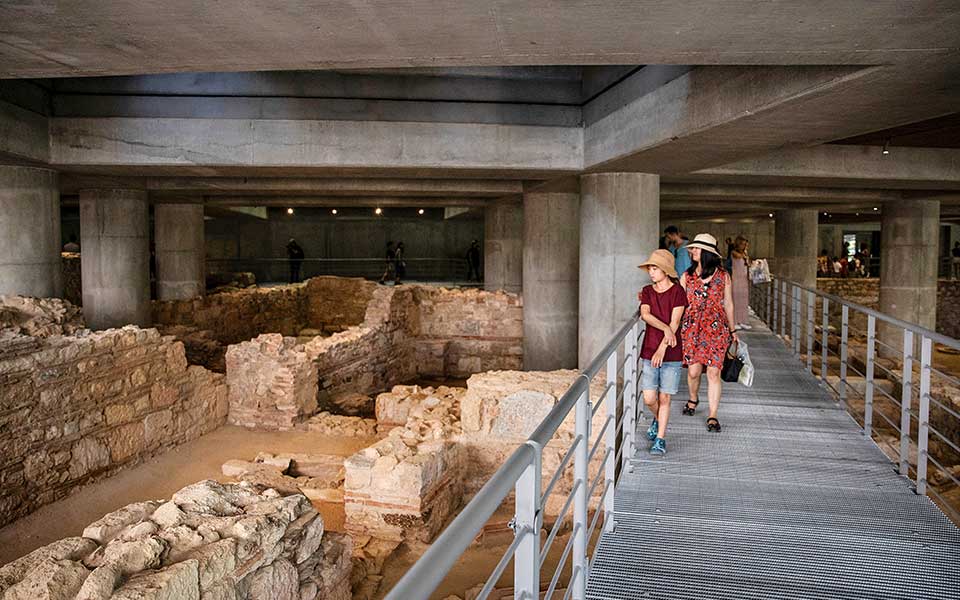
© Reuters/Alkis Konstantinidis
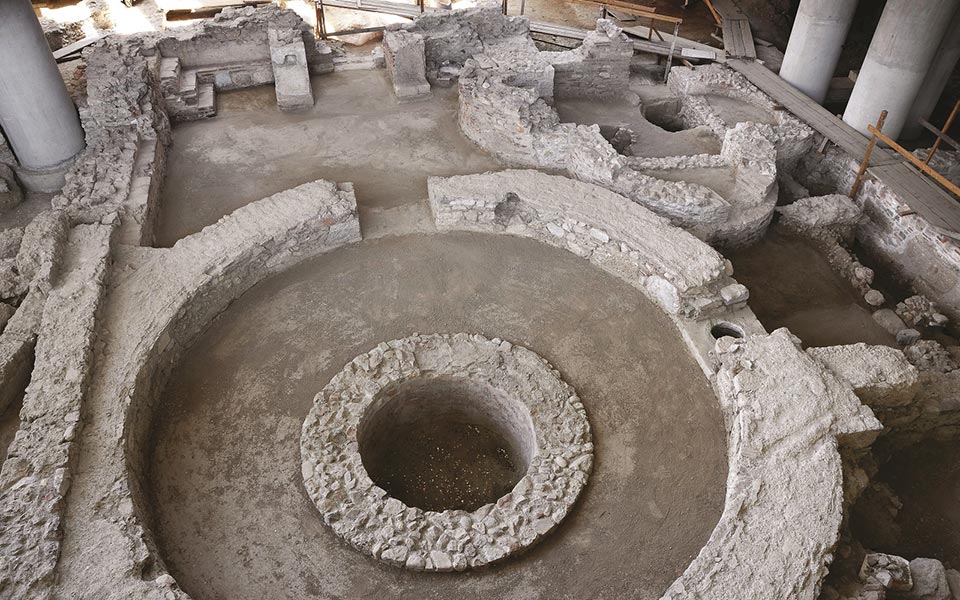
© Acropolis Museum. Photo Nikos Daniilidis
COMFORTABLE LIVING, TURBULENT HISTORY
An archaeological site presents its latest components on top. Beneath the Makrigianni site’s Byzantine ruins lie additional strata and disturbed remains indicative of earlier occupations. Houses of the Classical and Hellenistic eras (5th-1st c. BC) are poorly preserved, due not only to overbuilding, but also to destruction during the Roman general Sulla’s siege of Athens in 86 BC. Nevertheless, the affluence of the pre-Roman neighborhood was made clear by the discovery of three houses containing “androns,” men’s mosaic-paved banqueting rooms, each with spaces for seven dining couches.
After the Romans’ initial ravaging of Athens, marble workers, potters and bronzesmiths set up shop in the dilapidated district. By the mid-2nd century AD, however, the city’s residential quarters began recovering. The Makrigianni site now hosted closely-constructed, well-to-do homes.
It was in one such structure (West Bath) from this period that some of the greatest finds were made. Recovered from a well that supplied water to the bath was a cache of statues depicting gods and goddesses, including a young “Zeus Heliopolitanus” (late 1st c. AD). This distinctive form of Zeus wears a garment decorated with personifications of the “planets” in the ancient Greeks’ geocentric cosmos: Cronus, Zeus, Hera, Helios (Sun), Selene (Moon), Ares and Hermes. Also in the well were statues of Asclepius, Hygeia, Aphrodite, Eros Cybele and Hermes. The Zeus statue, along with other, smaller depictions of Eastern deities found on the site, reveals the spiritual importance of Eastern mystery cults in Roman Athens.
The affluence of Late Roman/Early Christian Athens remained undimmed, even after another invasion by the Herulians in AD 267. As the city recovered and underwent reorganization in the 4th and 5th centuries AD, Building Z, the upscale residence with its private bath, was erected in the eastern part of the site. In the 6th century, it was luxuriously renovated as the “villa urbana” (city villa) of some distinguished personage, featuring a semi-circular entranceway with a mosaic floor and staircase (visible through the transparent floor of the Museum’s exterior forecourt); an apsidal reception hall; and many mosaic-floored residential rooms further east.
However, with a continuing threat from the Slavs, who had raided Athens in AD 582, a new, apparently more defensive structure was added in the early 7th century. This fresh complex, Building E, featured wells, reservoirs and storerooms, where water and foodstuffs could be cached in troubled times; an upper-floor living area; a large apsidal reception hall; a small three-niched chamber that may have been a ceremonial dining room (triclinium) or chapel for private worship; and a circular tower-like structure.
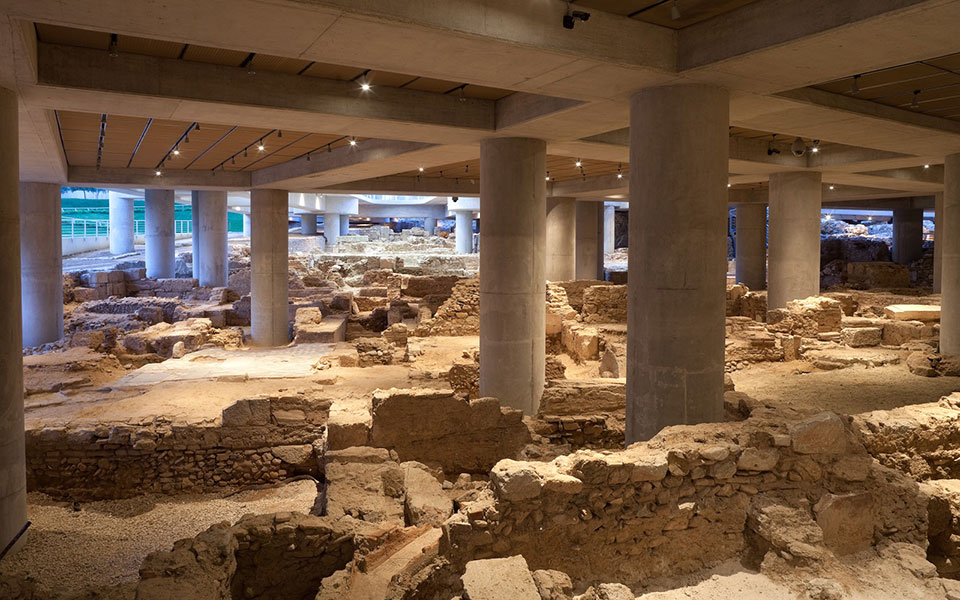
© Acropolis Museum. Photo Nikos Daniilidis
THRIVING INDUSTRIES
The final centuries of life at the Makrigianni site were marked by a shift in the district’s character. Following the abandonment of Buildings E and Z in the 7th century, the area became home to pottery and metalworking shops, evidenced by kilns, reservoirs, drains and other installations (8th-9th c.). After another period of abandonment in the 10th century, a new industrial quarter arose, with similar workshops, as well as residential spaces for the craftsmen (11th-12th c.).
Final desertion of the Byzantine neighborhood came in the early 13th century. Some six centuries later, when Athens was occupied by the Ottoman Turks, an elegant military hospital, designed by the Bavarian engineer Wilhelm von Weiler, was erected on the north side of the Makrigianni site where it still stands, at present accommodating the administrative offices of the Acropolis Museum and EPKA.
NEW LIGHT ON ANCIENT ATHENS
Today, the remarkable resilience of ancient Athens is laid bare in the excavations of this long-inhabited archaeological site. Important new conclusions concerning late antiquity in Athens have been reached as well, with Eleftheratou speaking of an era “once considered a period of decline and residential recession, but here presenting newly constructed buildings that prove Athenian urban life remained vital in these times.”
New exhibitions of artifacts recovered from the excavations and reflecting the vitality of day-to-day life in the Makrigianni neighborhood through the centuries are being prepared, and are scheduled to open before the summer of 2020.

